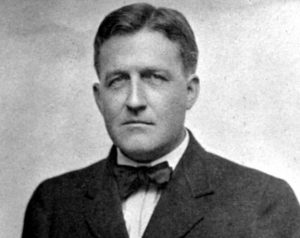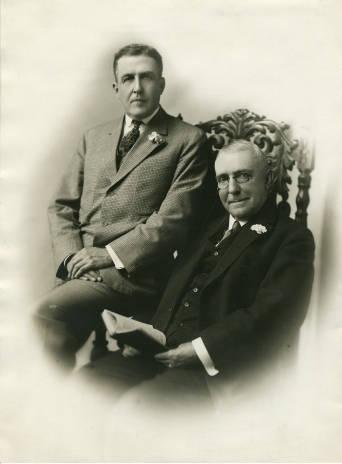
Photo info ...
Credit: Indiana Historical SocietyView Source
(Dec. 9, 1866-Dec. 22, 1947). The author of 29 books plus countless shorter works, Meredith Nicholson is best known for his popular light romances. His most valuable writings, however, are his historical essays, and his analyses of current events published in newspapers and magazines.
Born in Crawfordsville, Indiana, the son of a prosperous farmer, Nicholson moved to Indianapolis in 1872, where he discovered that schools “didn’t fit” him, and his formal education ended at an early age. His subsequent attempts to enter college failed because he could not meet the “mathematical requirements.” Consequently, he entered upon his life’s work “without benefit of college,” the title of one of his better essays, but his personal study habits served him well.
Nicholson worked as an office boy in a print shop, clerked in a drug store, studied shorthand and became a court reporter, and then became an apprentice in a law office. His talents were literary and journalistic rather than legal, and from 1885 until 1897, he held various editorial positions on the .

He began to contribute verses to the local press, followed by a book of his poetry, , which appeared in 1891. His talents clearly lay elsewhere, and, after his marriage to Eugenie Kountze, the daughter of a wealthy Omaha, Nebraska, banker, in 1897, Nicholson tried a career in business. This occasioned a move to Denver, where he found success but not happiness.
His first narrative book, (1900), a history of the state with emphasis upon its literary culture, appeared during his Colorado years and was also the catalyst that brought him back to Indianapolis and a career as a full-time writer. Between 1903 and 1925, he published an average of one book a year, most of them novels, but there were also three collections of essays, a second book of poetry, and even a co-authored play.
Several of these volumes achieved bestseller status. His most famous novel was (1905), a thrilling but scarcely believable mystery-romance set in northern Indiana. A more powerful novel, A (1912), explored changes in Midwestern society at the turn of the century. His last book, the author’s personal favorite, was a collection of biographical sketches titled (1929).
For reasons associated with both the onset of the Great Depression in 1929 and the death of his wife in 1931, Nicholson was unable to complete any more books. His work as a diplomat was more demanding than expected, but he proved effective as a representative of the United States and its governmental system in which he believed so firmly. Recurring health problems prompted Nicholson’s retirement from the foreign service in 1941, but he continued to write for local newspapers and to support the Allied effort during World War II.
A warm, gregarious, fun-loving man, Nicholson contributed both to the political and literary culture of his time. A member of Indiana’s “Big Four” men of letters (with , George Ade, and ) during the early part of the 20th century, Nicholson was considered the dean of Indiana writers at the time of his death in 1947. Although his romantic novels have not aged well and Nicholson is but slightly read and studied now, his essays of political and social commentary and his richly textured biographical sketches remain a valuable resource for the study of Midwestern culture at the turn of the century.
Nicholson was a dauntless booster of his home state and an ardent Democrat politically, although he never sought elective office. In his later years, he accepted an appointment from President Franklin Roosevelt to be the American minister in Paraguay (1933-1934), Venezuela (1935-1938), and Nicaragua (1938-1941).
makes its home in the former Nicholson home at 1500 North Delaware Street.

Help improve this entry
Contribute information, offer corrections, suggest images.
You can also recommend new entries related to this topic.